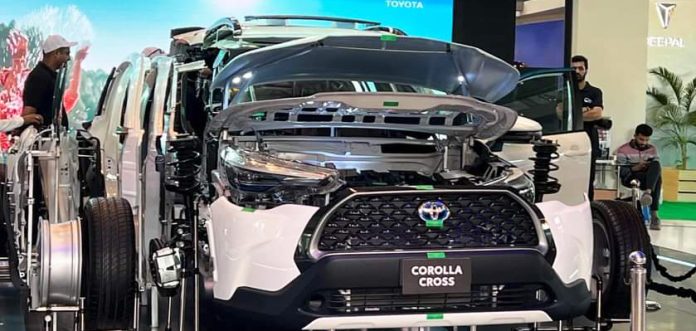Pakistan’s automotive industry has grown significantly over the past two decades, yet it remains heavily reliant on imported high-tech components and has not achieved the capability to design and manufacture a car from scratch. Despite having assembly plants, a strong supplier network, and government policies promoting localization, challenges such as limited R&D facilities, lack of advanced manufacturing technology, and small market size hinder the country’s progress toward producing a fully localized car. Overcoming these obstacles is crucial for achieving self-reliance, reducing import dependency, and fostering sustainable growth in the automotive sector.
The automotive industry has mushroomed in Pakistan since the last two decades with many assembly plants coming up and an increased demand for locally assembled as well as imported cars. The country is currently assembling different models but has not produced a car designed and manufactured from scratch within the country. This article discusses the facilities, capabilities, and challenges available to produce a fully localized car in Pakistan and the realistic level of localization that can be achieved.
Current Automotive Manufacturing Facilities in Pakistan
Pakistan’s automotive industry is dominated by assembly units, with a well-developed component supplier ecosystem and an emerging local vendor base. Pak Suzuki, Indus Motors (Toyota), and Honda Atlas are some of the leading car manufacturers with assembly facilities in the country, while Hyundai and KIA, which recently entered, have stiffened competition and increased investments in technology.
We have local:
Assembly Plants: Available plants can support vehicle assembly with a wide range of models from small cars to SUVs depending on imported CKD and SKD kits.
Body Fabrication and Welding Capacity: Pakistani manufacturers are capable of fabricating and welding car body frames. Simple and intermediate parts such as body panels, chassis and interior parts are gradually being made in Pakistan.
Paint Shops: Most assembly plants have modern paint facilities to allow multi-coat finishes and corrosion protection with high-quality painting processes.
Component Supplier Network: Pakistan has an active network of suppliers, which are producing critical parts, including seats, tires, batteries, exhaust systems, wiring, glass, and plastic components. Over 1,600 small and medium-sized enterprises are assisting the automotive supply chain in Pakistan.
Engine and Powertrain Facilities: Scaled up production of powertrain components such as air filters, gaskets, etc. In the country, there is no unit producing complete engine or transmission system.
Possible Localization of the Car Industry in Pakistan
Localization in the automobile industry defines up to which degree a car is assembled by local sources, such as labour, materials, and components. While Pakistan imports the more complex parts, right infrastructure with policy support could mean that it has a huge potential for localization in basic and mid-range vehicles.
Localization Stages-Key Components:
With the manufacturing setup, most of the basic vehicle parts like seats, dashboards, wheels, tires, batteries, window glass, and exterior lights can be localized. More than 60% of the non-mechanical parts have high potential of localization
Chassis, fuel tanks, exhaust systems, and parts for suspension will be locally produced but will depend upon relatively minor technological upgradation and vendor training have moderate localization potential
High technology components like engines, transmissions, electronic control units (ECUs), and sophisticated safety systems must be imported because Pakistan has relatively low technical capability for the accurate manufacture and high-technology applications can have low localization potential:
Localization Feasible by Vehicle Model:
Economy Models and Small Cars: These models require relatively low technology and have a high localization potential; up to 60-70%.
Mid-Range Cars: Imports in the form of electronics and performance components will provide an attuned level of localization, probably 40-50%.
Luxury and Premium Cars: As technology demands are higher, localization may be low, around 20-30%, with most critical parts imported.
Government Policies Support Localization
The government of Pakistan has introduced auto policies to encourage local production, reduce dependency on imports, and encourage vendor development. There is a framework for localization through the Automotive Development Policy 2016-2021 and the new Auto Industry Development and Export Policy 2021-2026, in which the following are practiced:
Import duties on localized components are reduced, which encourages manufacturers to source locally rather than import. Subsidies by the government for new entrants and electric vehicles attract both foreign and domestic investment to produce and assemble locally. Locally trained vendors can become suppliers of high-quality parts, thus helping in increasing the local supply chain.
Challenges to Attaining High Localization
Pakistan lacks high-tech R&D facilities required for the designing and testing of critical components like engines, transmissions, and ECUs. Investment in technical education and vocational training is required to develop local expertise in these areas. Quality automotive component production requires a significant investment in advanced manufacturing technology. Encouraging local businesses to invest in precision manufacturing will help bridge this gap. Local production of automotive parts requires a huge volume for economies of scale. Due to a relatively small automobile market in Pakistan, economies of scale cannot be easily achieved, especially for niche or premium components.
Government support, private investment, and transfer of technology would be inevitable to ensure successful production in Pakistan for the fully localized car. Collaborating with overseas manufacturers would promote knowledge and joint ventures among local businesses to develop technology and upgrade the quality of production. The production line could remain focused on higher demand models like budget cars and electric vehicles.
One of the most ambitious targets remains the car produced wholly in Pakistan. Pakistan does have some good ground on which to build facilities, workforce, and vendor base for increasing local content. Therefore, Pakistan can raise local car production in following years by utilizing available infrastructure, improving local capabilities of vendors, and formulating policies that will support localization. The Pakistani automotive sector, with a steady R&D focus, a developed workforce, and strategic investments will move toward self-reliance, job creation, and economic growth.
Article is written by Abdul Daiyem Final year student of B.S., Industrial Engineering from UMT and published in Automark’s printed and digital of January-2025 edition.
